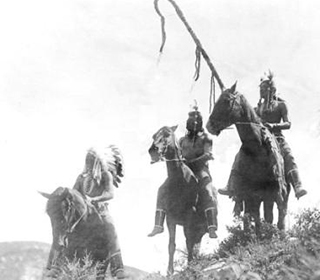These acts of bravery, or 'war counts', were recorded on a 'Coup Stick' and deeds were indicated in various ways including the use of notches and feathers. In order for a coup to count it had to be witnessed by other warriors and then officially recognized by tribal council. Native American Life - Counting Coup
The life, history and lifestyle of Native American Indians is a varied and fascinating subject. The following fact sheet contains interesting facts and information on Counting Coup. Counting Coup Fact Sheet for kids - Counting Coup Fact 1: Definition: The term derives from the French word 'coup' meaning to "blow or strike" and is defined as "a highly successful, unexpected strike, act, or move; a clever action or accomplishment"
- Counting Coup Fact 2: Warriors carried coup sticks into battle. The sticks came in different shapes and sizes but were typically a willow rod with a feather on the end. Coups were also claimed by using elk-horn riding quirts (horsewhips) or weapons such as bows, lances or spears
- Counting Coup Fact 3: The Plains Indian tribes such as the Crow, Cheyenne, Arapaho and the Sioux kept a close count of their brave deeds and these were displayed to indicate a warrior's strength and achievements in battles and in other dangerous situations
- Counting Coup Fact 4: The acts of bravery had to be witnessed by other warriors. An account of the event was then reported back to the elders of the tribe at the tribal council
- Counting Coup Fact 5: Awards such as eagle feathers were given in acknowledgment of acts of bravery and the way the feathers were displayed on headdresses or other regalia indicated the different types of coups that had been made
- Counting Coup Fact 6: Feathers were cut and worn in a certain ways. A feather could be notched, split or dyed red which conveyed the exploits of the wearer that was immediately recognised by other Native Indians refer to Meaning of Headdress feathers.
- Counting Coup Fact 7: Killing an enemy in battle was considered honorable, but greater awards were bestowed upon the warriors who could get close enough to his enemy to touch him and then return to safety
- Counting Coup Fact 8: It was relatively easy to kill an enemy at a distance using a bow and arrow or a rifle, however, it took greater courage get close enough to the enemy to touch them without getting injured or killed.
- Counting Coup Fact 9: The greater the risk, the higher the award. Approaching an enemy at close quarters risked serious injury or death. Touching the enemy under enemy fire, and escaping unharmed, showed great bravado and a lack of fear. It was the daring required of close contact for which the greatest awards were given. Such an action caused great humiliation and dishonor to the enemy.
- Counting Coup Fact 10: The highest award was given for touching an enemy, dead or alive, and escaping unharmed. Other awards were given for killing an enemy or scalping and enemy
- Counting Coup Fact 11: Coups were also given in other situations besides warfare. These situations all involved great danger such as the risks taken during a buffalo hunt, hunting dangerous animals such as bears, stealing horses from other tribes or capturing the enemies clothing or weapons
- Counting Coup Fact 12: When an enemy was killed, each of those nearest to him tried to be the first to reach him and touch him, usually by striking the body with the hand, bow, whip, or stick. Those behind raced up and also struck the body
- Counting Coup Fact 13: More than one warrior might touch the body of an enemy and receive credit, according to the order in which this was done. The Cheyenne counted coup on an enemy three times, any subsequent coups received no credit. The Sioux and Arapaho touched four times. Claiming coups often led to disputes, especially when several tribes fought together as allies against a common enemy.
- Counting Coup Fact 14: Amongst the Sioux, a feather worn straight up at the back of the head indicated a first coup, meaning he was the first to touch an enemy. The second man wore his feather slanted to the right, the third man to ouch the enemy wore his feather horizontally and the fourth wore the feather hanging down
- Counting Coup Fact 15: A warrior's record of his deeds were publicly recognised by his coup stick and the symbols he painted on his shield, his tepee, his horse and his clothing
- Counting Coup Fact 16: Coup Bars, similar to the epaulettes worn by US army officers, were added to War Shirts reflecting the battle experiences of the wearer
- Counting Coup Fact 17: The number of coups indicated a manís status to his tribe, they also functioned as a means of intimidation and warning to his enemies
- Counting Coup Fact 18: High social positions and status were afforded to the holder of many coups. The legendary Sioux Chief Red Cloud counted 80 coups.
|
